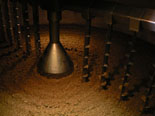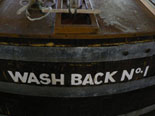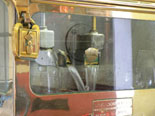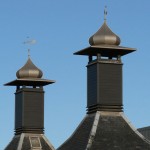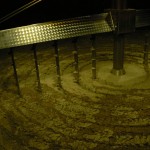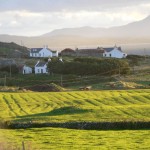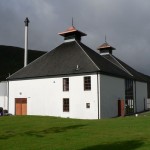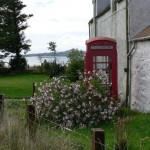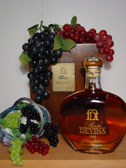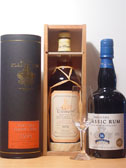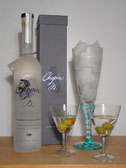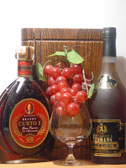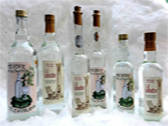Whisky of Whiskey?
– The uncrowned king of spirits!
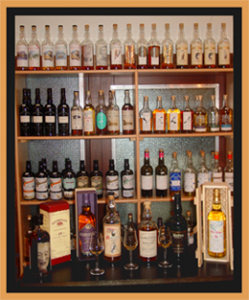 The spelling was until the beginning of the 20th Century uniform ‘Whisky’ in all the whiskey-producing countries. Then some distilleries in Dublin began to name their products ‘Whiskey’ to distance hemselves from their Scottish competitors. Generally write the Scots and Canadians ‘Whisky’ without ‘e’ and the Irishman and most Americans favor ‘Whiskey’.
The spelling was until the beginning of the 20th Century uniform ‘Whisky’ in all the whiskey-producing countries. Then some distilleries in Dublin began to name their products ‘Whiskey’ to distance hemselves from their Scottish competitors. Generally write the Scots and Canadians ‘Whisky’ without ‘e’ and the Irishman and most Americans favor ‘Whiskey’.
Why the whiskey is considered the king of the fine spirits? There is no other distillate, which offers such a wide range of different flavours. From country to country, region to region, the whisky is very different. The American whisky must be distilled by law at 51% of corn, however, there the Scottish or Irish malt whisky is maded by 100% malted barley. Only for all whisky is mandatory that they are produced as a distillate of grain, yeast and water to then be stored for a period of time in wooden
barrels.
As the Celtic name uisge beatha = water of life – suggests, whisky is an elixir of life and have always found its application in medicine. There is now scientific evidence that drinking 10 cl weekly, may reduce the risk of heart attack. Whisky and the Celtic culture are closely linked, therefore in many legends is spoking about it and give him something magical.
An old Scottish proverb says that whisky could change a negative into positive mood….
In this sense – here’s to you!
History of Whisky
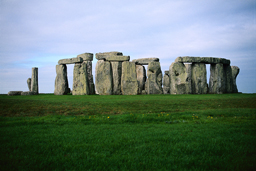 Nobody knows for sure who was the first to have the simple yet wonderful idea to transform plain barley into a precious spirit. There is agreement, however, on the fact that it is an inheritance of Celtic ancestors. The obtained spirit was regarded as a vital protection from wet autumn weather and icy winters with lots of snow – it was called uisge beatha, the water of life. No doubt, the process of distillation is an art which was cultivated in its origins in remote highland glens as well as in the monasteries of the lowlands. Today, more than 500 years later, Scotch Whisky is long-established as a gift of nature to epicures all over the world. In the same way as nature itself, it emanates from fire and water, and with proper care it vastly improves over time.
Nobody knows for sure who was the first to have the simple yet wonderful idea to transform plain barley into a precious spirit. There is agreement, however, on the fact that it is an inheritance of Celtic ancestors. The obtained spirit was regarded as a vital protection from wet autumn weather and icy winters with lots of snow – it was called uisge beatha, the water of life. No doubt, the process of distillation is an art which was cultivated in its origins in remote highland glens as well as in the monasteries of the lowlands. Today, more than 500 years later, Scotch Whisky is long-established as a gift of nature to epicures all over the world. In the same way as nature itself, it emanates from fire and water, and with proper care it vastly improves over time.
Production of Whisky
The 3 main components for producing malt whisky can be found in nature;
they are 1. peat / 2. barley / 3. water
Peat is abundantly available as a natural fuel, consisting of decomposed marsh plants such as moss, heather and sedges. Burning peat creates the smoke which is used for stopping the germination process of the barley which is spread out on a wooden floor above the fire. After drying, the barley is merged with water in a large copper pot, thus producing the so-called mash. The addition of yeast triggers the fermentation process – alcohol develops. Up to this point, the production of whisky is identical to that of beer! Then the alcoholic mixture passes the copper still for the first time. Strong heat transforms the alcohol into rising vapours which subsequently condense resulting in the so-called low wines. The distillation process (heating – cooling) is repeated, then the twice-distilled spirit is filled into wooden barrels for its final ripening. The duration of this barrel ripening can vary, yet it has to be at least 3 years, otherwise the spirit may not be called whisky!
 Scotch is derived from Scottish and designated actually only the origin of whisky.
Scotch is derived from Scottish and designated actually only the origin of whisky.
A strict legal definition of Scotch Whisky has been in place for many years. Today, Scotch Whisky is defined in UK law, and also protected at European Union and World Trade Organisation level as a recognised ‘geographical indication’.
This legal protection is vitally important. It protects Scotch Whisky from unfair competition and underpins Scotch Whisky’s reputation as being of the highest quality and integrity.
which has been produced at a distillery in Scotland from water and malted barley (to which only whole grains of other cereals may be added) all of which have been: processed at that distillery into a mash;
converted at that distillery to a fermentable substrate only by endogenous enzyme systems; and fermented at that distillery only by the addition of yeast;
which has been distilled at an alcoholic strength by volume of less than 94.8% so that the distillate has an aroma and taste derived from the raw materials used in, and the method of, its production;
which has been wholly matured in an excise warehouse in Scotland in oak casks of a capacity not exceeding 700 litres, the period of that maturation being not less than three years;
which retains the colour, aroma and taste derived from the raw materials used in, and the method of, its production and maturation, and to which no substance other than water and plain caramel colouring may be add
Also the Scotch must have an alcoholic content of 40%.
Malt – Single Malt
Malt Whisky

Malt is won from malted barley and is the raw material along with water and yeast for the production of malt whisky. He’s mostly distilled several times in a copper pot. Unlike Single Malt, it may contain distillates of different distilleries
Single Malt
For having the name Single Malt Whisky on the labelling can be only used malted barley whisky from a single distillery. Before bottling, usually selected barrels of the distillery are mixed together or married in the brands language. So, the Blend Master can affect its flavour and its taste. In the name must always be the age of the youngest whiskey this mixture are given. This can but unrestrictedly also older whiskey contained. Each Single Malt bottling therefore has its own individuality. Is recommended to enjoy Single Malt Whisky pur or with a few drops of water, so that his variety can develop fully.
Other Types of Whisky
 Single malt scotch whisky means a single malt whisky from Scotland.
Single malt scotch whisky means a single malt whisky from Scotland.
Single cask is bottled from a single barrel.
Vatted malt is a mixture of malt whiskies from several distilleries.
Pure malt is a seldom used term since its meaning is not entirely clear. In some cases it is used to designate a single malt, in other cases it stands for a vatted malt.
Grain whisky is produced on an industrial level in large, permanently producing, pillared stills. Common components are maize, wheat and raw barley, and the spirit has to ripen for at least 3 years in oak barrels.
Blended scotch whisky or, in short, blends are the result of a stroke of Scottish genius at around 1830 – 1850. Blended is a mixture of a small quantity of single malt and a large amount of grain whisky. Blends made it possible for less wealthy people to afford whisky, and thus the success story of Ballantine’s and Johnny Walker began.
Whisky Regions
 The Scottish malt whiskies are subdivided according to 3 regions of origin.
The Scottish malt whiskies are subdivided according to 3 regions of origin.
• Lowlands
• Highlands
• Isles
Each region contributes with its specific factors to influence the taste of the whiskies produced there – even in a blind tasting you can usually ascertain from which region the single malt originates.
Lowlands
Lowland whiskies are light in taste, with a light body, herbal and citrus aromas. One of the better-known Lowland distilleries, Auchentoshan, is the only one to continue the Lowland tradition of three-time distillation.
Highlands
The Highland region of Speyside is commonly called the heartland of whisky production. It is the home of more then half of all the malt whisky distilleries of Scotland. A Speyside malt usually tastes of sherry and honey; it is floral and mostly very complex. Some remarkably fruity whiskies, such as the Aberfeldy, originate in the eastern and southern Highlands. In the north you can find whiskies with aromas of heather and spice, probably stemming from the sandstone which dominates in this region.
Isles
The Isles whiskies are all characterised by their extremes – they are peatier, saltier, smokier, more iodinous… These strongly pronounced aromas can be explained by the proximity of the sea and the intensive climatic influences associated with these locations. The largest and best-known whisky island by far is Islay with its seven operating distilleries Ardbeg, Bruichladdich, Bunnahabhain, Bowmore, Caol Ila, Lagavulin, and Laphroaig. An eighth, Port Ellen, has, however, been closed for some years.
Japanese Whisky
 Japanese Whisky is known a few years ago in our country. Impressed by the world-wide success of whisky, the Japanese began producing their own brands in 1923. The Japanese have learned and perfected the knowledge about the burning skill of the Scots.
Japanese Whisky is known a few years ago in our country. Impressed by the world-wide success of whisky, the Japanese began producing their own brands in 1923. The Japanese have learned and perfected the knowledge about the burning skill of the Scots.
Blends are the most produced, very often they are mixed with Scottish Single Malt to improve the quality. Actually, this wouldn’t (more) necessary, because especially the Japanese single-barrel bottlings are the Scottish into nothing more. Maybe of the aged japanese code which practically forbids the acquisition of products in the own country to make or complete the inhouse products – so it’s rather to importe than to cooperate. Therefore some Scottish and American distilleries are in possession of the Japanese.
The world’s biggest malt distillery today lies in Japan. However, Japanese whisky is produced almost exclusively for the domestic market. Single Malt bottlings are very desired here.
Two of the most influential figures in the history of Japanese whisky are Shinjiro Torii and Masataka Taketsuru. Torii was a pharmaceutical wholesaler and the founder of Kotobukiya – later to become Suntory. Torii hired Masataka Taketsuru had studied the art of distilling in Scotland, and brought this knowledge back to Japan in the early 1920s. Whilst working for Kotobukiya he played a key part in helping Torii establish the Yamazaki Distillery. In 1934 he left Kotobukiya to form his own company—Dainipponkaju—which would later change its name to Nikka. These are two best-known Japanese distilleries.
How the Scottish Malt also the Japanese whiskey is divided into malt, pure malt, grain and blended whiskey.
Other Whisky countries
Irland
 In the 18th century, there were more than 2000 distilleries in Ireland. At present there are only 3 in operation. In Ireland there is no peat used for whisky production, except for the Connemara Malt. In contrast to Scottish whisky which is only distilled twice, the Irish whiskey is distilled three-times (except for the Auchentoshan malt whisky). The Irish spell their whiskey with ‘ey’ in order to distinguish it from Scottish whisky.
In the 18th century, there were more than 2000 distilleries in Ireland. At present there are only 3 in operation. In Ireland there is no peat used for whisky production, except for the Connemara Malt. In contrast to Scottish whisky which is only distilled twice, the Irish whiskey is distilled three-times (except for the Auchentoshan malt whisky). The Irish spell their whiskey with ‘ey’ in order to distinguish it from Scottish whisky.
Canada
 Scottish and Irish immigrants brought whisky to Canada. Canadian whisky is always blended and produced from several types of grain. The best-known Canadian whisky is Canadian Club.
Scottish and Irish immigrants brought whisky to Canada. Canadian whisky is always blended and produced from several types of grain. The best-known Canadian whisky is Canadian Club.
USA
 As with Canada, it was the European immigrants who brought the art of whisky production to the New World. In the course of the decades, the traditional Irish and Scottish distilling methods were altered, and ingredients such as maize, rye and wheat were preferred to traditional barley. As with the Irish, American whiskey is also spelled with ‘ey’.
As with Canada, it was the European immigrants who brought the art of whisky production to the New World. In the course of the decades, the traditional Irish and Scottish distilling methods were altered, and ingredients such as maize, rye and wheat were preferred to traditional barley. As with the Irish, American whiskey is also spelled with ‘ey’.
Exotic whisky
 Among the so-called exotic whisky countries, we would like to highlight New Zealand, India and Switzerland in particular. In both countries, proper single malt whisky is produced, if only in small quantities and not only blends.
Among the so-called exotic whisky countries, we would like to highlight New Zealand, India and Switzerland in particular. In both countries, proper single malt whisky is produced, if only in small quantities and not only blends.
Impressions of Scotland
Grappa ist eine ausschliesslich italienische Spezialität, die aus dem Trester (=die Schalen ausgepresster Weintrauben) gewonnen wird. Die Heimat der Grappa sind die nördlichen Regionen Italiens bzw. einige der südlichen Regionen des früheren Kaiserreiches Österreich-Ungarn: Trentino, Friaul, Venetien, Lombarei und Piemont. Ab dem 17./18. Jahrhundert hat sich – von den Klöster ausgehend – das Schnapsbrennen verbreitet.
Acquavite oder Uvedilanga sind 2 Ausdrücke, die Sie vielleicht im Zusammenhang mit Grappa schon gehört haben. Beide Ausdrücke stehen für eine weitere typisch italienische Spezialität, die streng genommen kein Grappa ist. Während der Grappa ein reiner Tresterbrand ist, wird beim Acquavite die ganze Frucht mit Fruchtfleisch verwendet, deshalb ist ein Acquavite fruchtiger als ein Grappa.
Fassausbau oder nicht? Ein klarer Grappa oder Acquavite hat kein Fassausbau, hat eine Abfüllung bereits ein wenig Farbe, dann handelt es sich um einen Brand mit Fassausbau. Je länger ein Brand in einem Fass reift, desto mehr Farbe erhält er. Eine Edelspirituose mit Fassausbau verliert an Fruchtigkeit, wirkt aber ründer und süsser. Die meisten Grappaliebhaber ziehen die Abfüllungen mit Fassausbau den Klaren vor, weil der Gesamteindruck (Nase-Mund-Abgang) einfach harmonischer ist.
Purer Genuss – Grappa ist zum abrundenden Element niveauvoller Ess- und Trinkkultur geworden. Grappa gilt heute als edles Destillat und steht für Lebensart, Gastlichkeit und Geselligkeit. Und auch die Küche mag vielfach auf Grappa als besonderes Geschmacksvergnügen nicht verzichten.
Die Schreibweise Rum, Rhum oder Ron deutet vielfach auf die Herkunft, respektive ist ein Verbleibsel der einstigen Kolonialmacht.
Rum – war britisch
Rhum – war französisch
Ron – war spanisch oder portugiesisch
Der Rum wie wir ihn heute kennen und schätzen, ist ein Produkt der Karibik und der Nordküste Südamerikas. Den Namen Rum dürften diesem Brand, so nimmt man an, später englische Seeleute gegeben haben. Die Geschichte des Brandes aus Zuckerrohr ist von Beginn an eng mit der Geschichte der Seefahrt verbunden. Freibeuter und Seeräuber, Schmuggler und Sklavenhändler, die in der Karibik ihr Unwesen trieben, tranken mit Vorliebe diesen Schnaps. Anlässlich der Eroberung von Jamaika 1655 durch die Englische Krone kamen zum 1. Mal Seeleute der Majestät mit jenem hochprozentigen Getränk in Berührung.
So unterschiedlich das Endprodukt auch sein kann, eines haben alle Rumsorten gemeinsam – dem Grundstoff Zuckerrohr, ein Nebenprodukt der Zuckergewinnung. Es gibt weissen Rum und mit bräunlicher Färbung. Die Färbung erhält der qualitativ hochwärtige Rum von der langjährigen Fassreifung. Die meisten bei uns erhältichen Rums sind Blends, ein Verschnitt aus vielen Rumsorten. Diese qualitativ schlechten Rums erhalten ihre Farbe durch Einfärben mit Karamel, da bei 3jährigen Rums oder jünger keine regelmässige Färbung durch die Fassreifung erzielt werden kann. Sollte der Rum aber weiss bleiben, reinigt man ihn über Aktivkohle.
Wodka oder Vodka (kommt vom Wort “voda” =Wasser) ist eine meist farblose Spirituose mit 37.5% bis 80%Vol. Alkoholgehalt. Er zeichnet sich besonders durch seinen fast neutralen Geschmack aus. Neben diesen reinen oder puren Wodkas werden heute auch aromatisierte hergestellt aus Früchten, Gewürzen, Extrakten oder Essenzen.
Die wichtigsten, traditionellen Produktionsländer sind Polen, Russland, Finnland, Schweden und die Ukraine. Nach der Oktoberrevolution 1917 sahen sich viele Russen gezwungen auszuwandern und damit war der weltweite Siegeszug des Wodkas nicht mehr aufzuhalten.
Das traditionelle Getreide zur Wodka-Herstellung in Osteuropa ist bis heute Roggen. Der daraus hergestellter Wodka schmeckt lieblich, weich, mild, leicht süsslich; daher gilt Roggen als der beste Ausgangsstoff. In westlichen Ländern verwendet man hauptsächlich Weizen, da er preiswerter und in grösserer Menge verfügbar ist. Kartoffeln werden auch seit Jahrhunderten verwendet. Der Geschmack des daraus gewonnenen Wodkas ist gewöhnlich schwerer und herber. Melasse (=Rübensirup, ein Nebenprodukt der Zuckerherstellung) gilt als der billigste und qualitativ schlechteste Rohstoff für Wodka. Der Geschmack des daraus gebrannten Wodkas ist meistens etwas süsser als der von Getreidewodka.
Wodka ist eine der wenigen Edelspiritousen, die gut gekühlt serviert und getrunken werden!
Brandy ist die internationale Bezeichnung für Weinbrandgetränke. Je nach Herstellungsverfahren und Herkunft besitzen diese Spirituosen daneben auch eigene Beizeichnungen z. B. Cognac aus dem Anbaugebiet rund um das gleichnamige Städtchen.
Spanien ist das Land mit der wahrscheinlich längsten Brandy-Tradition Europas und der grössten Brandy-Produktion der Welt. 90% der spanischen Brandys kommen aus der Region um Jerez de la Frontera an der Atlantikküste. Dieses Erzeugnis ist seit 1987 unter der Bezeichnung Brandy de Jerez geschützt. Wie Cognac und deutscher Weinbrand ist der spanische Brandy zu 100% aus Wein gebrannt.
In Frankreich werden allgemein Weinbrände als Eau-de-vie de vin bezeichnet. Französische Weinbrände aus dem Gebiet Charente werden als Cognac, Weinbrände aus dem Gebiet Gascogne als Armagnacbezeichnet; beides sind geschützte Herkunktsbezeichnungen.
In Armenien handelt es sich um ein reines Weindestilat und wird meist als Armenian Brandy bezeichnet. Der Grundwein darf nur aus einheimischer Produktion stammen.
Der norwegische Brandy besteht in der Regel aus gebranntem Wein unter Zusatz von einheimischen Alkohol, der zumeist aus Kartoffeln gewonnen wird.
In den Vereinigten Staaten versteht man unter Brandy in- und ausländische Alkoholika, die aus reinem Weinalkohol hergestellt werden, z.B. Cognac oder Weinbrand.
In Ungarn wird ein aus Traubenweindestillat (unter Zusatz von Aromastoffen) hergestelltes Erzeugnis als Brandy bezeichnet.
Cognac ist ein nach der französischen Stadt Cognac und dem umliegenden Weinbaugebiet benannter Brandy (Weinbrand) aus Weissweinen. Als geschützte Herkunftsbezeichnung ist der Name heute für das dort hergestellte Erzeugnis reserviert.
Seit 1930 erfolgt die Einteilung in sechs Crus, aufgelistet in der Reihenfolge der Wertschätzung:
- Grande Champagne
- Petite Champagne
- Borderies
- Fine Bois
- Bons Bois
- Bois ordinaires
Hinzu kommt noch die Reifeklassifizierung, wie lang ein Cognac im Fass gereift ist, wobei nur die jüngste Komponente zählt. Ein Cognac mit der Bezeichnung
- Very Special/VS muss 2 Jahre im Fass gelagert sein.
- Very Old oder Very Superior Old Pale/VS oder VSOP müssen mindestens 4 Jahre im Fass gereift sein.
- eXtra Old/XO müssen sogar 6 Jahre im Fass gelagert sein.
Portwein gehört zu den Klassikern in der Welt der edlen Getränke, eigentlich erstaunlich, denn Portwein passt in keine “Schublade”. Er ist mit seinen meist 20 Volumenprozent Alkohol keine Spirituose aber auf der anderen Seite ist Portwein auch kein Wein im ursprünglichen Sinne, dessen natürliches Alkoholmaximum ja bei etwa 15%vol liegt. Mit Alkohol aufgespritzt sitzt er gemütlich zwischen den Stühlen der Weine und Spirituosen.
Seinen Ursprung findet man im Douro-Tal im heutigen Portugal. Diese Gegend war schon zu Römerzeiten bekannt für edle Weine und wurde deshalb kurzer Hand dem römischen Reich einverleibt. Die Aussichten war so vielversprechend, dass an der Douro-Mündung die Siedlung Cale mit dem Hafen Portus Cale gegründet wurde, woraus später der Name Porto und letztlich auch der Landesname Portugal abstammte.
Absinth ist eine Spirituose, welche aus Anis, Wermuth, Fenchel und Kräutern hergestellt wird. Der erste Absinth wurde im Val-de-Travers (NE) schon anfangs des 18. Jahrhunderts hergestellt. Die regionalen Kräuter verleihen ihm einen einzigartigen Geschmack. Anfänglich wurde Absinth als Heilmittel verkauft.
1797 wurde das Rezept der Familie Henriod von Major Dubied gekauft und zusammen mit seinem Schwiegerson Henri Louis Pernod gründete er die erste Absinth-Brennerei. Absinth war das erste hochprozentige Getränk, welches auch Damen der guten Gesellschaft in der Öffentlichkeit trinken durften.
Der Alkoholkonsum stieg rasant an, da Absinth billiger als Wein war. Um 1900 wurden immer mehr Stimmen für das Verbot von Absinth laut, da es gesundheitsschädigend sei und ausserdem auch Hallunzinationen hervorrufe. In der Schweiz gab es dafür sogar eine Volksentscheid, welcher 1910 den Verkauf von Absinth verbot.
Erst seit 2005 ist der Absinth-Verkauf wieder legalisiert worden und die diversen Distillierien des Val-de-Travers sind sehr stolz auf eine 250jährige ununterbrochene Geschichte der Absinth-Produktion.
Gin is mostly colourless and is made from grain or molasses and usually gets its flavour from the addition of juniper berries and coriander or other spices. Gin got its name in England in the 17th century, when the French and Dutch brought a schnapps called “jenever” with them.
Today we basically distinguish between 5 types:
– London Dry Gin (dry)
– Dry Gin (dry, less juniper)
– Plymouth Dry Gin (sweeter and spicier)
– Old Tom Gin (sweeter)
– Genever (sweeter and more aromatic)
Gin is the main ingredient in many cocktails, including Gin Tonic, Gin Fizz, Martini, Basil Smash, etc, but can also be enjoyed neat if it is of high quality.

 Deutsch
Deutsch Français
Français
